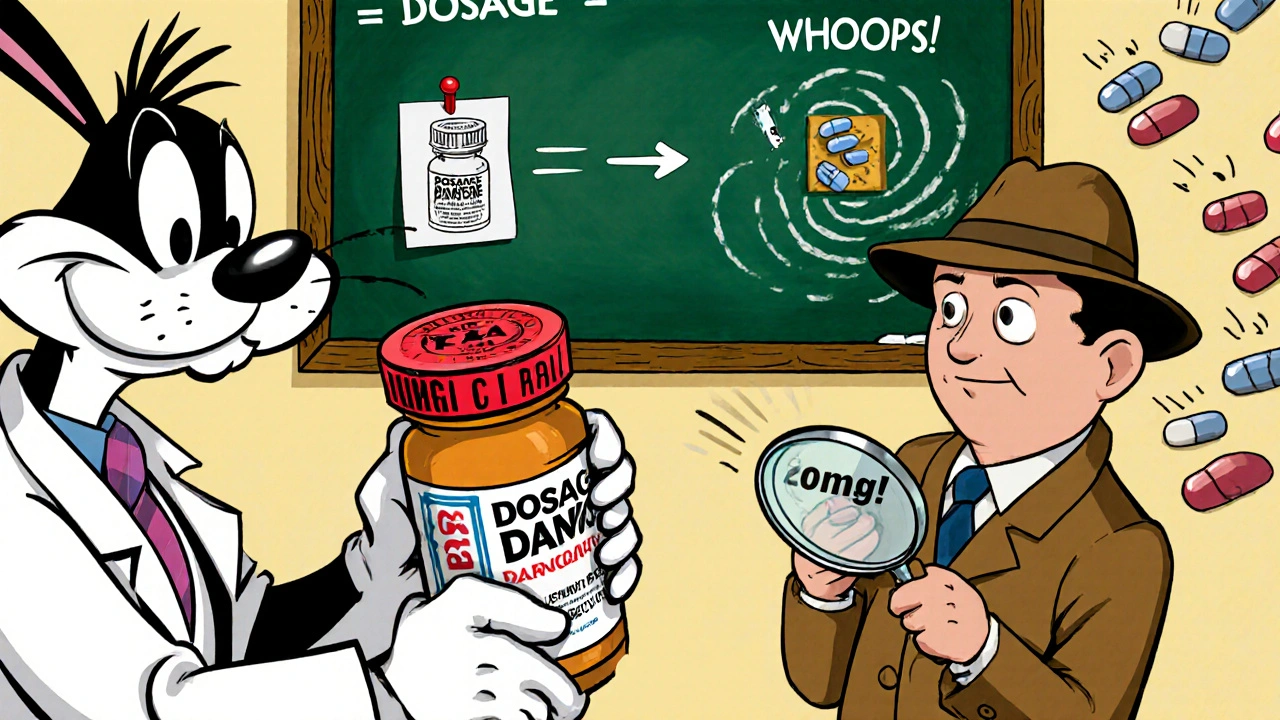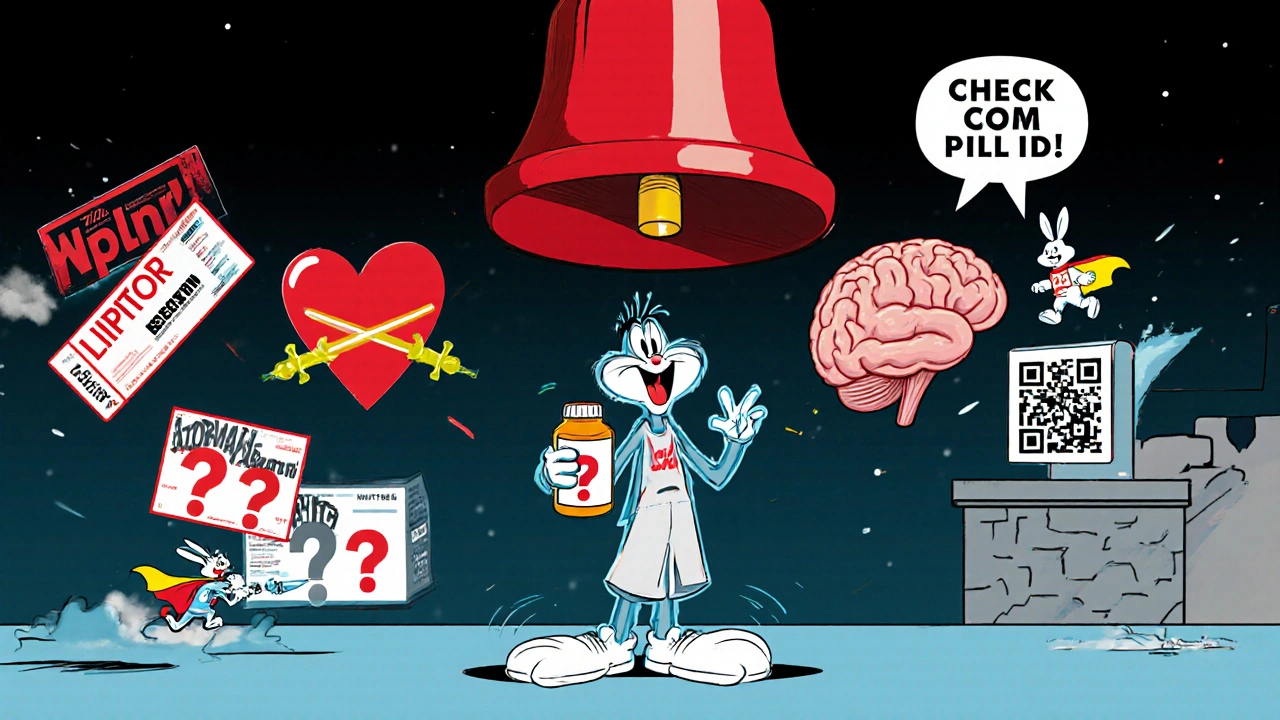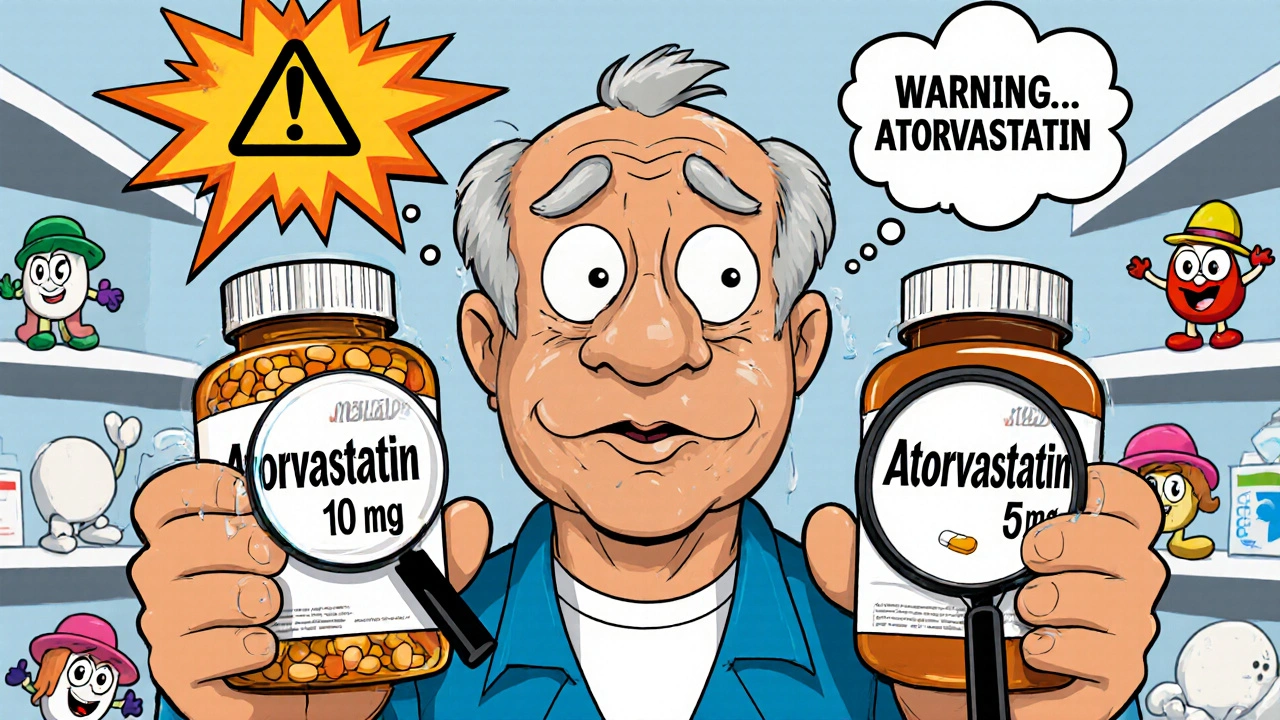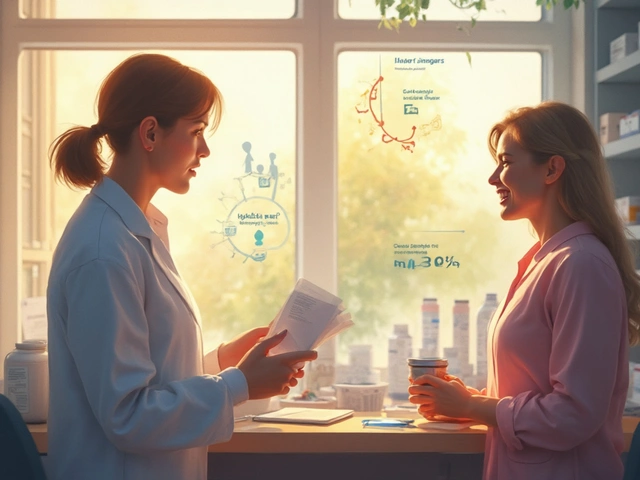Every time you pick up a refill, your pills might look different. Same medicine. Same dose. But now they’re orange instead of white. Smaller. Bigger. Even shaped like a star instead of a circle. It’s normal-but it’s also where mistakes happen.
You’re not imagining things. Your old pills and new pills aren’t the same. And that’s not a mistake. It’s how generics work. But if you don’t check the label, you could end up taking the wrong thing-twice the dose, the wrong drug, or even mixing two meds you thought were the same. This isn’t rare. Over 60% of people over 65 rely on the color or shape of their pills to know what they’re taking. When that changes, confusion follows. And confusion leads to errors.
What to Look for on Every New Prescription Label
Don’t just grab the bottle and walk out. Take two minutes. Compare the new label to the old one, side by side. You’re not checking for perfection-you’re checking for safety.
- Patient name - Is it yours? Simple, but mistakes happen. A wrong label on the wrong bottle can be deadly.
- Medication name - Look for both the brand name (like Lipitor) and the generic name (like atorvastatin). If the generic name matches what you’ve taken before, you’re good. If the brand name changed unexpectedly, ask why.
- Dosage strength - This is critical. Is it 10mg? 5mg? 20mg? A single digit mistake can cause serious harm, especially with blood thinners, seizure meds, or thyroid drugs.
- Manufacturer - You’ll see something like “Mfg: ACCORD HEALTHCARE” or “Made by Teva.” This tells you who made the pill. If this changes from your last fill, it’s a new generic version. Not necessarily bad-but worth noting.
- Rx number - This is your prescription ID. It’s unique to you. If it’s the same as last time, it’s the same refill. If it’s totally different, ask if this is a new prescription.
- Refills left - How many times can you refill this? If you used to have 3 refills and now you have 0, something changed. Maybe your doctor stopped it. Or maybe the pharmacy made a mistake.
- Prescriber and date - Who ordered it? When? If your doctor’s name is gone or the date is months old, that’s a red flag.
One thing you won’t find on the label? Expiry date. In Australia and many U.S. states, pharmacies aren’t required to print it. But if you’re unsure how old your pills are, ask the pharmacist. Don’t guess.
Why Your Pills Look Different (And Why That’s Okay)
Generic drugs are cheaper because they don’t have to spend millions on branding. But here’s the catch: the law says they can’t copy the shape, color, or size of brand-name pills. So even if the active ingredient is exactly the same, the pill can look totally different.
Let’s say you take levothyroxine for your thyroid. Last month, your pills were small, white, and had “125” stamped on them. This month, they’re large, yellow, and say “Teva 125.” Same dose. Same effect. But now you think you got the wrong med.
This happens all the time. In fact, 90% of prescriptions in the U.S. are filled with generics. And those generics come from different manufacturers-sometimes even different countries. Each one makes the pill differently. That’s legal. That’s normal. But it’s confusing.
For most people, this doesn’t matter. But for some, it does. If you take blood thinners like warfarin, seizure meds like phenytoin, or thyroid drugs like levothyroxine, tiny differences in how the body absorbs the drug can cause problems. Your doctor might have written “brand substitution not permitted” on your prescription. If that box is checked, the pharmacy is not allowed to switch you to a different generic. If you see a new pill and that box isn’t checked, ask if the pharmacy changed it.
How to Spot a Dangerous Change
Not all changes are harmless. Here are the red flags that mean stop-and call your pharmacist right away:
- Different active ingredient - If your old label said “atorvastatin” and the new one says “rosuvastatin,” you’ve been switched to a completely different drug. This is serious.
- Different strength - 10mg to 20mg isn’t a small change. It’s a doubling. If you’re on a narrow-therapeutic-index drug, that could cause a stroke, overdose, or organ damage.
- Missing “brand substitution not permitted” - If your doctor specifically asked for no substitutions, and your new pills came from a different maker, the pharmacy may have ignored your doctor’s order.
- Multiple pills in one bottle - If you used to take one pill a day, and now you’re getting two different pills in the same bottle, that’s a mistake. Don’t take them unless you’ve confirmed with your pharmacist.
One real case from a patient in Brisbane: She took a new refill of her blood thinner and noticed the pills were smaller. She thought it was the same. But the dosage had dropped from 5mg to 2.5mg. She didn’t notice until she started feeling dizzy. Her INR levels dropped dangerously low. She had to go to the hospital. She didn’t check the label.

Tools to Help You Verify Your Pills
You don’t have to guess if your new pills are right. There are free, easy tools to check them.
Drugs.com Pill Identifier - Go to the website. Select your country (Australia). Then enter the pill’s color, shape, and imprint (the letters or numbers stamped on it). The tool will show you a photo and the exact drug name and strength. Compare that to your old pill. If they match, you’re good. If not, call your pharmacist.
Take a photo - When you get a new prescription, snap a picture of the pill inside the bottle. Keep it on your phone. Next time you refill, compare the photos. One Reddit user saved her life this way. She saw the new pills were twice as big as the old ones. She called her pharmacist and found out they’d switched her from a 10mg to a 20mg tablet. She almost took two pills thinking it was the same dose.
Call your pharmacist - Seriously. Don’t feel bad. Pharmacists expect this question. Ask: “Is this the same generic as last time?” or “Did the manufacturer change?” They can tell you if the new version is bioequivalent. If you’re on a high-risk drug, ask if they can keep you on the same manufacturer. Many pharmacies can do that if you ask.
What to Do If Something Doesn’t Match
If you find a mismatch, don’t take the pills. Don’t assume it’s a mistake. Don’t wait until your next appointment.
- Call the pharmacy immediately. Have your old bottle and new bottle ready. Read them both out loud.
- Ask: “Is this the same medication and dose as my last fill?”
- If they say yes but the label doesn’t match, ask them to check the original prescription from your doctor.
- If they can’t explain it, call your doctor’s office. Ask them to confirm the prescription.
- If you’re still unsure, don’t take the pills. Bring them back to the pharmacy and ask for a new fill.
Pharmacists are trained to catch these errors. But they can’t catch them if you don’t speak up.

How to Make This Easier Going Forward
Prevention beats correction. Here’s how to stop this from happening again:
- Use one pharmacy - If you switch pharmacies, your pill history gets lost. Stick with one. They’ll track your refills and flag changes.
- Ask for electronic prescriptions - Handwritten prescriptions have a 61% error rate. Electronic ones? Less than 1%. Ask your doctor to send it directly to the pharmacy.
- Keep a medication list - Write down every drug you take: name, dose, frequency, manufacturer, and why you take it. Update it every time you get a new prescription. Show it to your pharmacist and doctor.
- Use a pill organizer - If you take multiple pills a day, use a weekly box. Fill it once a week. That way, if a new pill looks different, you’ll notice it before you take it.
- Ask about long-term generics - If you’re on a high-risk drug, ask your pharmacist: “Can you keep me on the same manufacturer?” Many will do it if you ask.
By 2025, most prescriptions in Australia will use standardized labels with simpler language and QR codes that link to digital instructions. But that’s still coming. Right now, you’re the last line of defense.
Final Reminder: You Are Your Own Safety Net
Doctors don’t see your pills. Pharmacists don’t watch you take them. You do. That’s why comparing your new prescription label to your old one isn’t just a good habit-it’s a lifesaving habit.
It takes two minutes. It doesn’t cost anything. And it could stop you from making a mistake that sends you to the hospital.
Next time you get a refill, pause. Look. Compare. Ask. Your body will thank you.
Why do my pills look different every time I refill my prescription?
Because you’re likely getting different generic versions. Generic drug makers aren’t allowed to copy the shape, color, or size of brand-name pills. So even if the active ingredient and dose are identical, the pill can look completely different. This is normal and legal, but it can cause confusion. Always check the label-not the appearance.
What should I do if my new pills have a different manufacturer?
It’s usually fine. Different manufacturers make the same generic drug. But if you’re taking a narrow-therapeutic-index drug-like warfarin, levothyroxine, or phenytoin-small differences in absorption can matter. Call your pharmacist and ask if they can keep you on the same manufacturer. Many pharmacies can do this if you request it.
Can I trust the color and shape of my pills to know what I’m taking?
No. Relying on color or shape is risky. A 2022 survey found 42% of older adults use pill appearance to identify their meds-but that’s how errors happen. A pill that looks like your old one might be a completely different drug. Always check the label for the active ingredient and dosage. Use the Drugs.com Pill Identifier if you’re unsure.
What’s the most dangerous mistake people make with prescription labels?
Taking two different drugs thinking they’re the same. For example, mixing up lisinopril (for blood pressure) and losartan (also for blood pressure) because both are small white pills. Or doubling up on a dose because the new pill looks smaller. These mistakes cause thousands of hospital visits each year. Always compare the active ingredient and dosage on the label.
Should I ask my pharmacist to keep me on the same generic manufacturer?
Yes-if you’re on a high-risk medication like blood thinners, thyroid drugs, or seizure meds. Small differences between generic versions can affect how your body absorbs the drug. Most pharmacies can accommodate this request. Just ask: “Can you fill this with the same manufacturer as last time?” It’s your right.
What if the label says “brand substitution not permitted” but I still got a generic?
That’s a pharmacy error. If your doctor checked “brand substitution not permitted,” the pharmacy is legally required to give you the brand-name drug. If you got a generic instead, call the pharmacy immediately. They must correct it. You may also want to notify your doctor.
Is it safe to take expired medication if the label doesn’t show an expiry date?
No. In Australia, pharmacies aren’t required to print expiry dates on prescription labels. But the medication still expires. If you’re unsure how old your pills are, ask your pharmacist. Don’t take pills that are more than a year old unless you’ve confirmed they’re still safe. Expired meds can lose potency or become unsafe.





liam coughlan
November 22, 2025 AT 14:09Just grabbed my refill and noticed the pills were yellow instead of white. Checked the label - same generic name, same dose. Took a pic like the post said. Pharmed said it was a new batch from Teva. Cool. I’m good.
Maeve Marley
November 23, 2025 AT 22:34I used to rely on how the pill looked - white round = my blood pressure med, blue oval = my thyroid. Then one day, my thyroid pills turned into little green triangles with ‘L4’ stamped on them. I panicked, called my pharmacist, and they laughed and said, ‘Yeah, we switched manufacturers.’ I almost didn’t take them. Don’t be like me. Always check the label. Even if it’s 2 a.m. and you’re half-asleep. Two minutes saves you from a trip to the ER. Seriously. Save your future self some trauma.
James Gonzales-Meisler
November 25, 2025 AT 02:44This whole post feels like a public service announcement written by a pharmacist who’s tired of explaining the same thing to 50 people a day. I get it. But honestly? If you’re that worried about your meds, maybe you shouldn’t be taking four different prescriptions. Just saying.
Navin Kumar Ramalingam
November 25, 2025 AT 08:38Wow. A whole article about checking labels? I mean, I guess it’s cute that people still need hand-holding with generics. In Germany, we just trust the pharmacist. If they give you a pill, it’s the right one. Maybe if you spent less time staring at pill shapes and more time reading pharmacology, you wouldn’t need this guide.
Shawn Baumgartner
November 25, 2025 AT 13:20Let’s be real - this isn’t about generics. This is about Big Pharma’s profit-driven pill-switching schemes. You think the pharmacy randomly changes manufacturers? Nah. They’re pressured by insurance to push the cheapest version, even if it’s bioequivalent in theory but not in practice. And your doctor? They don’t even know what’s in your bottle. The system is rigged. You’re not paranoid. You’re the only one awake.
Cassaundra Pettigrew
November 26, 2025 AT 19:21Ugh. I hate how we let foreign manufacturers make our meds. Teva? Accord? Who even are these people? In America, we used to make our own pills. Now some guy in Bangalore is stamping out my thyroid med and I’m supposed to just… trust it? I’m not taking a pill that looks like a candy from a 99-cent store. Call my doctor. I want the brand. I don’t care if it costs $50 more. My life isn’t a budget spreadsheet.
Brian O
November 26, 2025 AT 21:14My grandma used to take 12 pills a day. She’d forget which was which. So we started taking photos of each bottle when she got a refill. Then we made a little chart on the fridge: Pill A = white oval = 10mg atenolol, Mfg: Mylan. Pill B = blue capsule = 25mg hydrochlorothiazide, Mfg: Teva. She didn’t have to guess anymore. She lived to 94. Small habits, big results. Don’t underestimate the power of a phone camera.
Steve Harvey
November 28, 2025 AT 13:01Ever wonder why the label doesn’t show expiry dates? Because the FDA and pharmacies are in cahoots. They want you to keep buying new bottles. Expired meds are still safe for years - but they won’t tell you that. I’ve got pills from 2019 that still work. I’ve tested them. The system is lying to you. Don’t trust the label. Trust your gut. And maybe Google the batch number.
Gary Katzen
November 29, 2025 AT 08:32I’ve been on warfarin for 12 years. I’ve switched manufacturers 7 times. Never had an issue. But I always check the label. Always. I don’t care if you think I’m overcautious - I’d rather look silly than end up in the hospital. If you’re on a high-risk med, just do the two minutes. It’s not hard. It’s not a burden. It’s basic self-respect.
ryan smart
November 29, 2025 AT 15:26USA: We pay more for meds than anyone. Then we get different-looking pills. And now you want us to take pictures? Call the pharmacy? This is why I just stop taking my stuff. Too much hassle. I’d rather risk it.
Sanjoy Chanda
December 1, 2025 AT 10:23I’m a caregiver for my dad. He’s 78, has 8 meds, and can’t read small print. So I made a little card for each one: picture of the pill, name, dose, manufacturer, and the Rx number. Laminated it. Keeps it in his wallet. Now he just shows it to the pharmacist when he gets a refill. No more panic. No more mistakes. It took 20 minutes once. Now it saves us 2 hours a month. Worth it.
Sufiyan Ansari
December 3, 2025 AT 03:08The phenomenon of pill variability is not merely a pharmacological curiosity, but a profound metaphor for the fragmentation of trust in modern healthcare systems. When the physical embodiment of healing - the pill - becomes unrecognizable, the patient is forced into epistemological doubt: How can one trust the invisible active ingredient when the visible form is in constant flux? This is not merely about dosage, but about ontological security. One’s body becomes a site of uncertainty, where identity - both medical and existential - is mediated by corporate supply chains and regulatory arbitrage. We must not reduce this to a checklist. We must interrogate the system that renders the body a passive recipient of algorithmic substitution.
megha rathore
December 3, 2025 AT 11:30OMG I JUST REALIZED MY NEW PILL IS A DIFFERENT SHAPE 😱 I THOUGHT I WAS GOING CRAZY!! I’M TAKING MY MEDS NOW BUT I’M SCARED!! 😭😭😭
Manish Pandya
December 4, 2025 AT 22:36My cousin in Delhi got switched from one generic to another and ended up with a rash. Turned out the new one had a different inactive ingredient - corn starch instead of lactose. She’s allergic. Never thought to check. Now she carries a little card in her wallet with every med’s manufacturer and filler info. I did the same. If you’re on more than three meds, this isn’t optional. It’s survival.
prem sonkar
December 5, 2025 AT 00:53wait so if the pill looks diffrent but the name is same its ok? i thought they were diffrent drugs lol